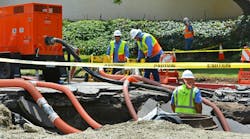… And up went river levels. Whether learned via newspaper photos and television clips or glimpses into one’s own backyard, the general population knows the effects of this springtime flood routine all too well.
The skies opened especially wide over the Midwest this June, and torrential rains left rivers violently swollen. Storms and levee-bursting floods—some of which shattered record water levels dating back to the early 20th century—killed at least two dozen people, injured many more, forced home and business evacuations and swallowed thousands of acres of crops.
It will take significant planning and manpower, not to mention billions of dollars, to begin restoring the region’s sense of life as usual. In the meantime, everyone from the local grocer to top government officials will be theorizing about who or what to blame for the floods and devastation.
Is climate change responsible? Aging infrastructure? Insufficient funding? Indifference? Some experts point to bad meteorological luck; of course it will flood, they say, when 500-year rains pour over already saturated soil, much of which had yet to be planted due to unusually chilly spring temperatures. Others have suggested that this type of natural disaster may not be so natural after all—that modern farming practices and urban development in floodplains have destroyed the natural drainage cycle.
The truth probably lies in some combination of these and related factors. The most important conclusion to be made is that the vast majority of speculations can be traced back to human actions. The storm water industry should consider the events of this June a call to action; supplying information, support and technologies to help promote responsible decision making and keep flooding in check is demanding, yes, but an urgent obligation.
Download: Here

